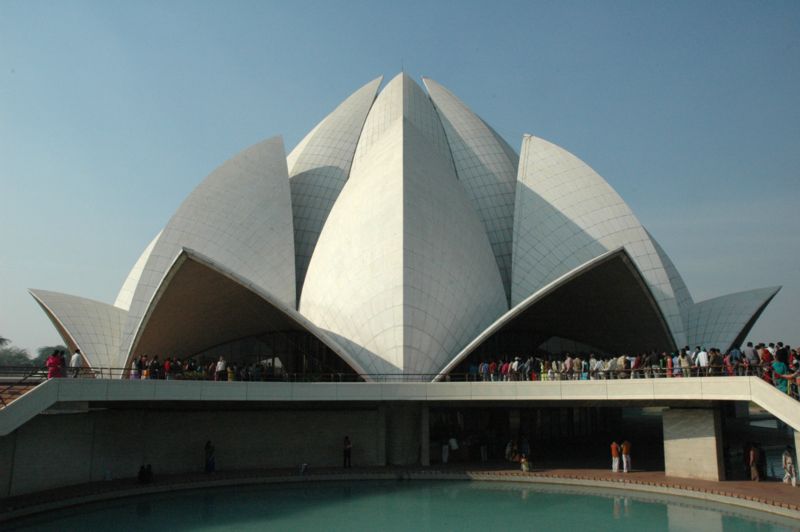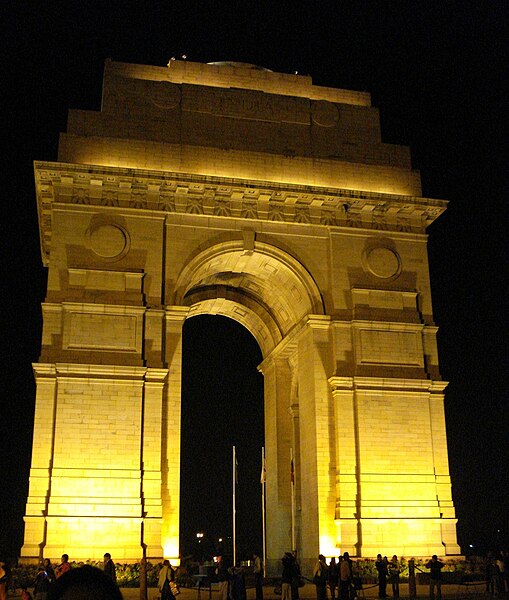 | ||
| India Gate |
1. India Gate
The names of the soldiers who died in these wars are inscribed on the walls. It was completed in 1931. Burning under it since 1971 is the Amar Jawan Jyoti (the flame of the immortal warrior), which marks the Unknown Soldier's Tomb.
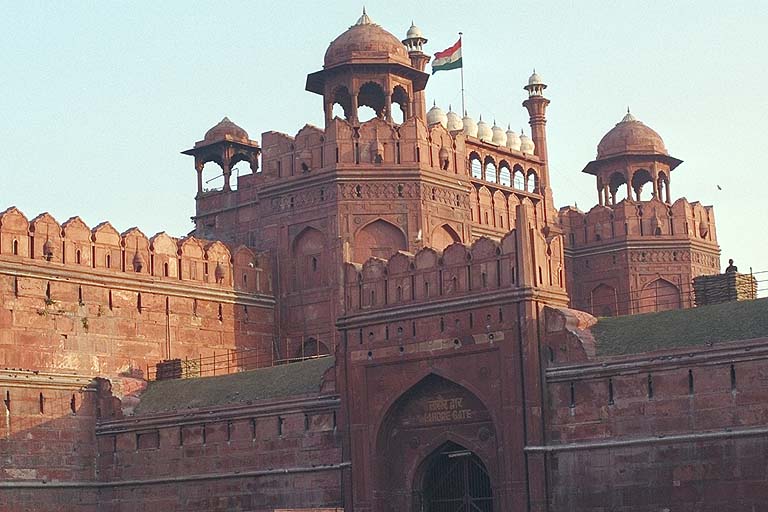 |
2. Red Fort
The Red Fort and the city of Shahjahanabad was constructed by the Emperor Shahjahan in 1639 A.D. The layout of the Red Fort was organized to retain and integrate this site with the Salimgarh Fort.The planning and aesthetics of the Red Fort represent the zenith of Mughal creativity which prevailed during the region of Emperor Shahjahan. Red Fort showcases the very high level of art form and ornamental work.
The art work in the Fort is a synthesis of Persian, European and Indian art which resulted in the development of unique Shahjahani style which is very rich in form, expression and colour.
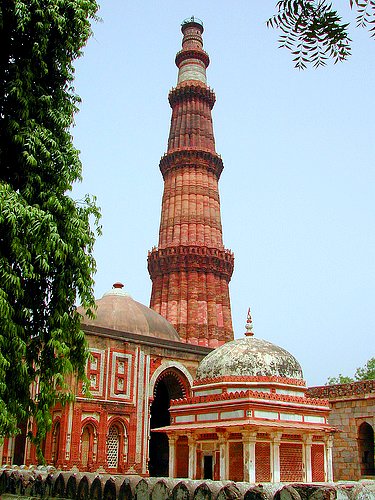 |
Qutub Minar is the tallest brick minaret in the world, and an important example of Indo-Islamic Architecture. The tower is in the Qutb complex in South Delhi, India. The Qutub Minar and its monuments are listed as a UNESCO World Heritage Site.
The Qutub Minar is 72.5 metres high (237.8 ft) with 399 steps leading to the top. The diameter of the base is 14.3 metres wide while the top floor measures 2.75 metres in diameter.
The place where Qutub Minar stands today was once occupied by about 20 Jain temples.
Also located in the Qutab complaex is the Iron pillar of Delhi. It is one of the world's foremost metallurgical curiosities. The pillar is almost seven meters high and weighs more than six tons. It was erected by Chandragupta II Vikramaditya. The pillar is made up of 98% wrought iron of pure quality, and is a testament to the high level of skill achieved by ancient Indian iron smiths in the extraction and processing of iron. It has attracted the attention of archaeologists and metallurgists as it has withstood corrosion for the last 1600 years, despite harsh weather.
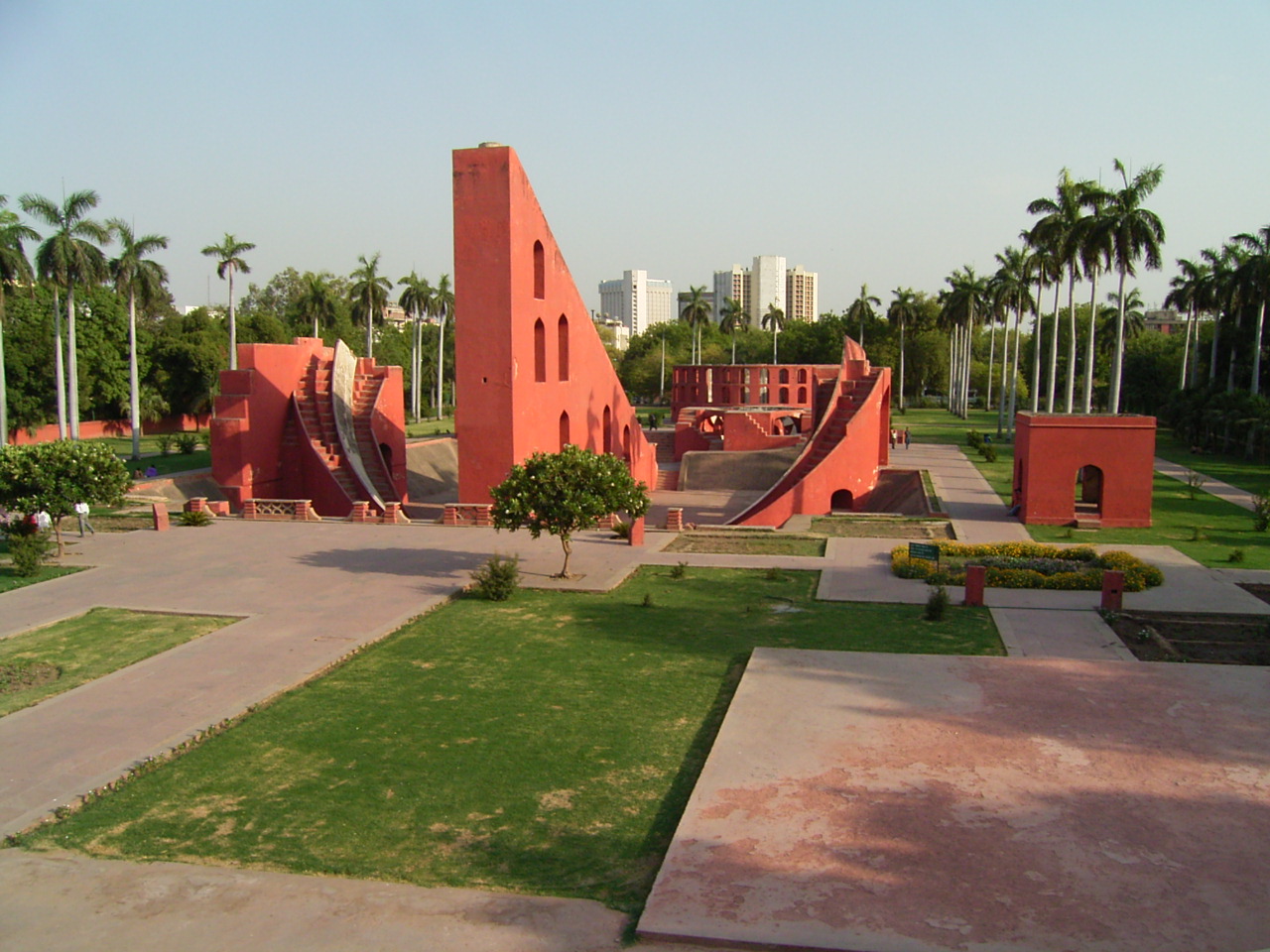 |
The Jantar Mantar is a collection of architectural astronomical instruments, built by Maharaja Jai Singh II from 1724 onwards.
The shadows cast by these instruments were formerly used to calculate time, lunar and solar calendars, time as wells astrological movements, all with an incredible degree of accuracy.
Jai Singh later had another similar observatory, now known by the same name, built for him at Jaipur.
5. Lotus Temple
The Bahá'í House of Worship, popularly known as the Lotus Temple, is a Bahá'í House of Worship and also a prominent attraction in Delhi. It was completed in 1986.
Inspired by the lotus flower, its design is composed of 27 free-standing marble clad "petals" arranged in clusters of three to form nine sides. It was designed by an Iranian architect named Fariborz Sahba.
It has won numerous architectural awards and been featured in hundreds of newspaper and magazine articles.
The Bahá'í House of Worship, popularly known as the Lotus Temple, is a Bahá'í House of Worship and also a prominent attraction in Delhi. It was completed in 1986.
Inspired by the lotus flower, its design is composed of 27 free-standing marble clad "petals" arranged in clusters of three to form nine sides. It was designed by an Iranian architect named Fariborz Sahba.
It has won numerous architectural awards and been featured in hundreds of newspaper and magazine articles.
6. Humayun's Tomb
If you think Humayun's Tomb looks a bit like the Taj Mahal in Agra, that's because it was the inspiration for the Taj Mahal's creation. The tomb was built in 1570, and houses the body of the second Mughal emperor, Humayun. It was the first of this type of Mughal architecture to be built in India, and the Mughal rulers followed it up with an extensive period of construction all over the country. The tomb is part of a greater complex that's set amongst beautiful gardens.
- Location: Nizamuddin East, New Delhi. Near the Nizamuddin train station, off Mathura Road.
- Entry Cost: $5 or 250 rupees. Free for children under 15 years.
- Opening Hours: Sunrise until sunset, daily. It's best viewed in the golden light of the late afternoon.
7. Gandhi Smriti
A visit to Gandhi Smriti will show you the exact spot where Mahatma Gandhi, affectionately referred to as the Father of the Nation, was assassinated on January 30, 1948. He lived in the house for 144 days up until the time of his death. The room that he slept in, kept exactly how he left it, and the prayer ground where he held a mass congregation every evening are both open to the public. Plenty of photos, sculptures, paintings, and inscriptions are also on display.
- Location: 5 Tees January Marg, central New Delhi.
- Entry Cost: Free.
- Opening Hours: From 10 a.m. to 5 p.m. Tuesday to Sunday.
8. Garden of Five Senses
The Garden of Five Senses is another peaceful place to come to escape the hustle and bustle of the city. However, it's no ordinary garden. As its name suggests, the Garden of Five Senses has been specifically designed to awaken all five senses. The sprawling 20 acre site beckons with a vibrant display of thoughtfully landscaped plants and flowers, waterfalls, rocks, quirky sculptures, murals, ceramic bells, and spiral walkways. The amphitheater often has live music. There are also restaurants and bars (check out the groovy Zoo at night) to relax in.
- Location: Said-ul-ajab village, M.B. Road, close to the Mehrauli heritage area in New Delhi. Near Saket.
- Entry Cost: Free.
- Opening Hours: Daily from 6.00 a.m. to 9.00 p.m.
9. Jama Masjid
Jama Masjid is another marvelous treasure of the Old City, and is the largest mosque in India. Its courtyard can hold an incredible 25,000 devotees. The mosque took 13 years to build, and was completed in 1650. A strenuous climb to the top of its southern tower will reward you with a stunning view across the rooftops of Delhi. Be sure to dress appropriately when visiting the mosque or you won't be allowed in. This means covering your head, legs and shoulders. Attire is available there.- Location: Opposite Chandni Chowk, Old Delhi. Near the Red Fort.
- Entry Cost: Free, but a camera fee applies.
- Opening Hours: Daily, except when prayers are being held from 12.15 p.m. to 1.45 p.m. It closes just before sunset.
10. Lodi Gardens
Lodi Gardens provides a serene retreat from city life, and is the place to come if you're feeling tired and worn out. The vast Gardens were built by the British in 1936 around the tombs of 15th and 16th century rulers. Joggers, yoga practitioners, and young couples all enjoy this park.
- Location: Lodi Road, not far from Humayun's Tomb.
- Entry Cost: Free.
- Opening Hours: Daily, but Sundays are particularly busy.
